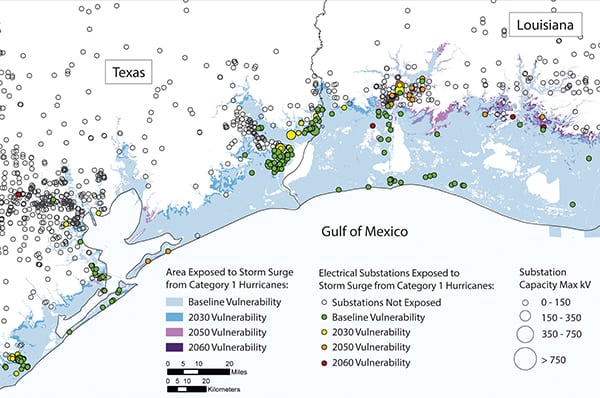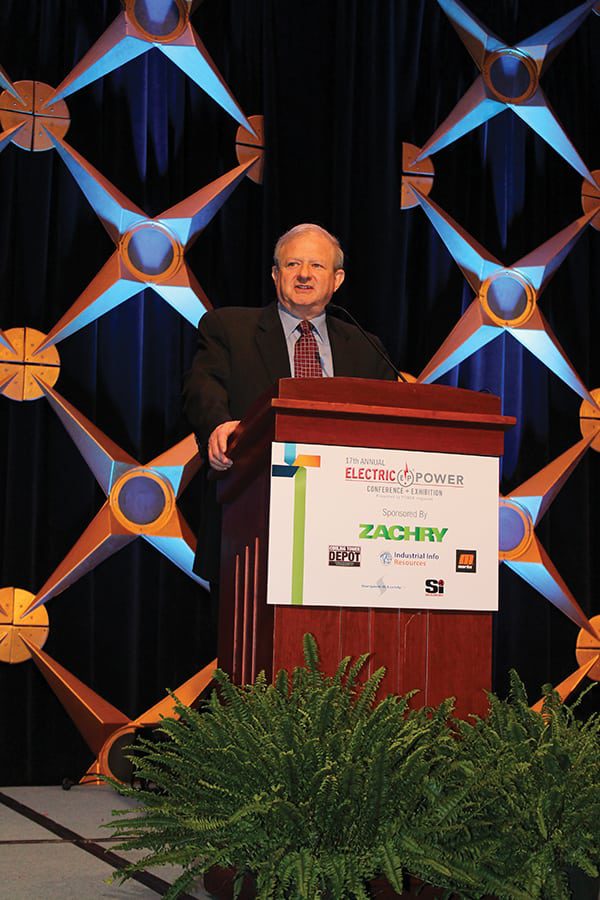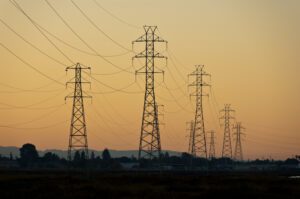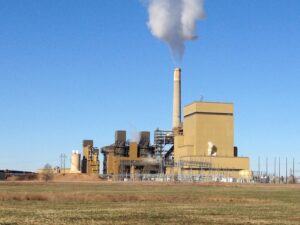With unprecedented changes and challenges facing the U.S. energy sector, the Department of Energy has spearheaded a comprehensive assessment of the nation’s energy policy. Released the same day as ELECTRIC POWER 2015 opened, the first installment of this review was highlighted in the conference’s keynote address.
U.S. energy infrastructure needs not just substantial investment for the future but also considerable rethinking about its role and functions in order to be positioned to deal with a rapidly changing energy landscape and evolving threats from cyber attack and climate change.
That was the message from William F. Hederman Jr., Department of Energy (DOE) deputy director for energy systems and integration and senior advisor to the secretary, who delivered the keynote address to the ELECTRIC POWER 2015 Conference & Exhibition in Rosemont, Ill., on Apr. 21 (Figure 1).
Hederman spoke on the day the DOE released the first installment of the Obama administration’s Quadrennial Energy Review (QER). He discussed the goals and background of this first-ever comprehensive study of the nation’s energy sector, which identifies the threats, risks, and opportunities for U.S. energy and climate security, with the goal of enabling the federal government to translate policy goals into a set of integrated actions.
The QER, available on the DOE website is the result of a Jan. 9, 2014, directive from President Obama, as part of his Climate Action Plan, to provide “an integrated view of, and recommendations for, Federal energy policy in the context of economic, environmental, occupational, security, and health and safety priorities.”
A Seismic Shift
Hederman said the overarching goal of the QER was to find ways for the administration to “do fewer things at cross purposes and more things that are mutually reinforcing” with respect to energy policy. It came about in part because of a suggestion early in the administration from now–Energy Secretary Ernest Moniz and White House Director of the Office of Science and Technology John Holdren, who recommended a comprehensive, integrated assessment of energy policy while they were on the President’s Council of Advisors for Science and Technology.
The impetus for the review came from the recognition that much of existing U.S. energy infrastructure was built to service an energy landscape that no longer exists. The fossil fuel sector has seen enormous shifts in production and distribution patterns, the grid has seen dramatically expanded renewable and distributed generation, and policy decisions are challenged by new environmental concerns. In addition, this mismatch is exacerbated by delayed investments in modernization and repair.
The QER involves more than 20 federal agencies—though the DOE provided much of the staffing and analysis—and will be released in several installments. The first addresses infrastructure for energy transmission, storage, and distribution. The intent, Hederman said, was “not to collect dust” but to provide action-oriented recommendations.
The review has three broad goals—economic competitiveness, energy security, and environmental responsibility—which Hederman acknowledged can conflict. “We entered this effort with the recognition that there are tradeoffs, and that’s what most public policy is about: multiple and sometimes conflicting objectives.”
One of the underlying issues is the lack of data about much of how current infrastructure operates. “As a former energy industry executive,” he said, “I recognize that sometimes that data does not exist because it’s too expensive to create it.” The first step, though, is identifying what data is needed.
The Backbone of the Power Sector
Infrastructure was the first subject, Hederman said, because everything else depends on it, and it will need to change as the power sector changes. “We’re looking across energy at these connected networks. Rather than report in the traditional way, we wanted to force both ourselves and our readers to be thinking differently about this.”
That means enhanced focus on a range of challenges: resilience, reliability, safety, energy security, climate change, and cyberattacks. In looking at all this, he said, “the importance of regional variations came up time after time.”
Much of the challenge stems from the deeply public-private nature of U.S. energy infrastructure, with large portions privately owned and operated but equally large elements owned, operated, or heavily controlled by the states or the federal government. Additionally, energy infrastructure reaches across local, state, and international boundaries, creating a highly complicated regulatory environment.
For that reason, Hederman said, “it’s important that we not ever think in terms of one-size-fits-all solutions here.”
In addressing these challenges, regulatory reform is one of the goals, he said. The QER identifies a number of challenges, such as ratemaking processes that can make spending on grid resilience measures difficult to recover. Worse, it notes, “Quantitative measures of adequacy of resilience investments, or even a commonly accepted method for determining the appropriate level of resilience at either the transmission or distribution level, do not exist.”
Addressing this, again, requires a variety of approaches, Hederman said.
“We recognize the need for multiple business models going forward. The traditional model of making money by selling more electricity is unlikely to be the only way to proceed in the future.”
But since the DOE “is neither a regulator nor the right body to be making these decisions,” he added, the goal of the QER is to provide as much information as possible for decision-makers to move forward.
Transport Challenges
Dependence on infrastructure to move energy resources—both electricity and fuels—has grown dramatically even as threats to that infrastructure have expanded and demands on it have shifted substantially. The growth in gas production has had “a profound effect on coal,” he noted, which has had ripple effects on coal transport. That in turn caused challenges to rail transport—of both coal and crude oil. This is a subject the DOE previously spent little time on, meaning the regulatory structure has become antiquated.
Meanwhile, the boom in oil and gas production has meant a rapid shift from import to export, something existing infrastructure was not built to support. The QER notes that 45% of the nation’s gas pipeline system was built prior to 1960, with substantial portions still composed of leak-prone cast iron.
“We are very much supportive of pipelines,” Hederman said, “but they can’t be built as quickly as the volume changes.”
The problems go beyond pipelines and railways. The QER found that “our waterborne infrastructure is in the worst state of any infrastructure the energy industry relies on,” Hederman said. Likewise, the Strategic Petroleum Reserve—established during the 1970s energy crisis when the global oil market was vastly different—needs attention and does not work well.
In addressing challenges to the electric grid, Hederman noted that a lot of work is necessary to enhance resiliency. Distributed generation, and especially energy storage, will be important. “That is a technology that could totally change the game.” That said, while the DOE is supporting a lot of research and development in energy storage, Hederman noted that “everyone is hopeful, but we’re not there yet. But that is clearly the magic bullet” for the future grid.
Threats Are Growing
Hederman also said that the DOE and the Department of Homeland Security are working very closely with industry to stay informed about cyber threats to energy infrastructure. “The threat is quite serious, and it involves nation states as well as other very sophisticated malicious people.”
The threats go well beyond cybersecurity. The QER highlights the range of natural threats, from climate events to seismic activity. These, naturally, vary widely by region, but aging of the system and the dramatic shifts in utilization of existing infrastructure has meant the traditional view of natural risks is no longer accurate. For example, hurricanes in the Gulf of Mexico are no longer nearly as disruptive to the natural gas system as they once were. But changes in reliance on natural gas have meant other areas, such as the Northeast, are vulnerable to severe weather in ways they were not in the past.
In addition, Hederman said, “the physical activity has picked up,” and the attacks “seem to be more sophisticated than they have been in the past.”
On environmental issues, Hederman noted that climate change was the most important such aspect in the QER. Indeed, concerns about climate change permeate nearly every element the QER addresses, from increased storm activity to sea level rise endangering key electrical transmission substations (Figure 2) to drought restrictions on inland waterways.
 |
| 2. Rising threat. This map from the Quadrennial Energy Review shows at-risk substations along the Gulf Coast under projected scenarios for sea-level rise. Source: Department of Energy |
The QER also looks specifically at ways that energy infrastructure contributes to climate change and at ways that modernizing infrastructure could help limit it.
“We point out that both in technologies that require long-distance movement and ones that are local, there are ways to reduce the carbon footprint. We think that an underlying theme here is that there needs to be a trend towards lower greenhouse gas emissions.”
Infrastructure is a source of greenhouse gas emissions, but improvements to it—such as expansions to the electric grid to enable greater renewable generation and CO2 pipelines to support carbon capture and sequestration—also hold considerable promise for reducing them.
The most notable finding on greenhouse gas emissions, Hederman said, was methane emissions from natural gas transmission and distribution infrastructure. “There is a lot of room for improvement,” he said. ■
—Thomas W. Overton, JD is a POWER associate editor.











